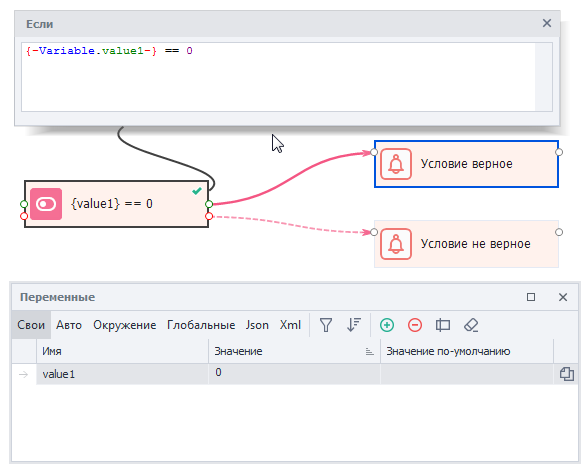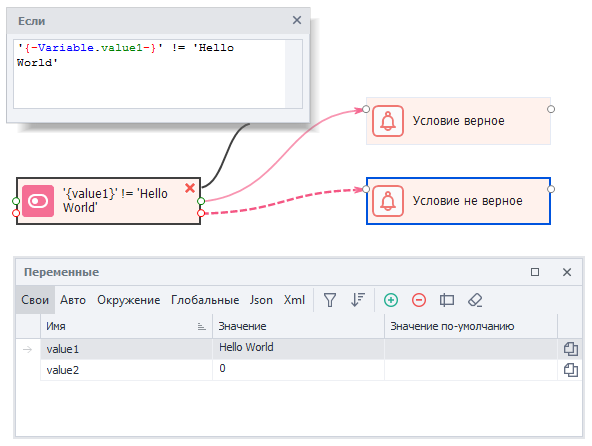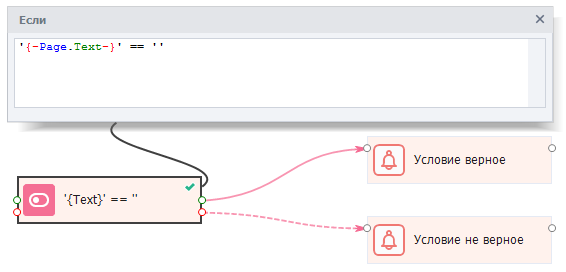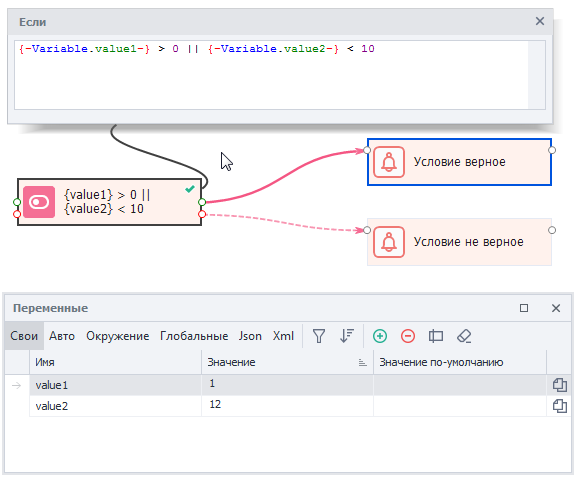IF Operator
Description.
The IF block is one of the main logical actions used in ZennoDroid. It works using logic from JavaScript. Logical operators are used for comparison.
For example, in the simplest form, the if operator compares two values. If the operator’s condition is true, the block gets the value True (it goes out through the green branch), and if it’s false — False (through the red branch).
In the action’s properties there’s an input field — you can insert project and environment variables there, as well as constants. The IF block only works with two data types: numbers and strings.
What it’s used for:
- Compare number values;
- Match text strings;
- Check conditions.
How to use the IF action?
Adding to the project.
Through the context menu: Add action → Logic → If.

Example #1
Let’s look at a simple example to understand how this operator works:

1. Create a variable value1 and set it to 1.
2. Add the IF block via: Logic → If.
3. In the block properties field, insert the operand: {-Variable.value1-}
4. Add the equals operator: ==
5. Insert the second value to compare: the constant 1.
6. If you run the block now, it’ll end on the green line (a green check will appear). That’s because the value is correct (True), since variable value1 equals 1.
7. But if you change the variable value to 2, the block will end on the red line (a red cross will appear). That’s because the value is wrong (False).
In this example we used number data and the == comparison operator. Next, we’ll check out the Not Equals operator: !=
Example #2.
For text data and variables, you must use quotes (single or double). But for numbers they are not needed. Otherwise, the comparison won’t work right.

1. Create a variable value1 and set it to “Hello World“.
2. Add the IF block like this: Logic → If.
3. In the block property field, insert the operand: {-Variable.value1-}
4. Add the not equals operator: !=
5. Insert the second value to compare: the constant “Hello World“.
6. If you run the block now, it’ll end on the red line. That’s because the value is wrong (False), since the variables are equal (but we are using the Not Equals operator).
7. When you change the variable value1 to “Goodbye World“ and run the block again, it’ll end on the green line (True).
Example #3
You can also use comparison to check if there’s at least some text loaded on a page.

1. Check the environment variable {-Page.Text-} for emptiness.
2. If there’s no text on the page (it’s empty), the block will go through the green branch (True).
3. Then you can reload the page or add an extra pause, waiting for the page to load.
The IF block is also often used in counter loops to compare with some maximum value.
Available operators.
Table of all operators:
| Operator | Description | Usage example |
|---|---|---|
< | Less than | 1<2 |
> | Greater than | 5>3 |
<= | Less than or equal | 7 <= 10 |
>= | Greater than or equal | 8 >= 8 |
== | Equal | “Hello” == “Hello” |
!= | Not equal | “Hello” != “Bye” |
&& | Logical AND | “Hello” != “Bye” && 5>3 |
| || | Logical OR | “Day“ == “Night” || 2 > 1 |
The OR operator ||
This operator is written as two vertical slashes. It lets you compare several conditions in a chain, going left to right. The block will output True if at least one of the conditions came out true. To get False, all the conditions have to be false.

1. Set variable {-Variable.value1-} to 1, and {-Variable.value2-} to 12.
2. In the action’s input field, write: {-Variable.value1-} > 0 || {-Variable.value2-} < 10.
3. Even though the second comparison is not correct, the block still ends on the green branch. That’s because OR returns True if at least one comparison is true.
4. Change the first variable’s value to -6 — then the block gives False, because all values are false.
The AND operator &&
The AND operator is written as two ampersands && and returns True when all arguments are true, and False if even one is false.
Let’s see how this operator works with text strings.

In this case both arguments are true. Variable value1 is not (Not equal) to “Hello“, and value2 is exactly (Equal) to “World“. So the block ends on the green branch.
The AND && operator has higher precedence than OR ||, so AND runs first if they’re both in the same block.